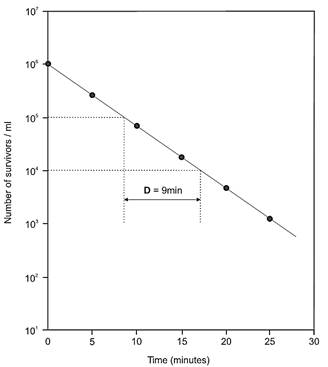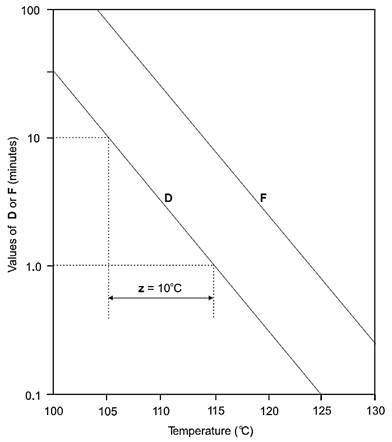


 النبات
النبات
 الحيوان
الحيوان
 الأحياء المجهرية
الأحياء المجهرية
 علم الأمراض
علم الأمراض
 التقانة الإحيائية
التقانة الإحيائية
 التقنية الحيوية المكروبية
التقنية الحيوية المكروبية
 التقنية الحياتية النانوية
التقنية الحياتية النانوية
 علم الأجنة
علم الأجنة
 الأحياء الجزيئي
الأحياء الجزيئي
 علم وظائف الأعضاء
علم وظائف الأعضاء
 الغدد
الغدد
 المضادات الحيوية
المضادات الحيوية|
Read More
Date: 2025-05-05
Date: 20-3-2016
Date: 18-3-2016
|
Parameters for evaluating the heat resistance of microorganisms
Two parameters are used to evaluate the heat resistance of microorganisms: the decimal reduction time (D value), which is determined based on the survival curve, and the temperature coefficient (z value) which is determined through the thermal destruction curve (Stumbo, 1973).
1.1 Survival curve and decimal reduction time ( D value)
In the destruction of microorganisms exposed to a constant lethal temperature, the reduction of the number of viable cells with time occurs at an exponential rate. This means that, in a chart with the logarithm of the number of survivors on the y axis and the exposure time on the x axis (Figure.1), the survival curve obtained is a straight line, described by equation (1) of the first order:
Log N0 – Log Nf = t/D (1)
N0 = initial number of microorganisms
Nf = final number of microorganisms (number of survivors)
t = time (in minutes) of exposure to the constant lethal temperature
D = time (in minutes) of decimal reduction
The D value, also called the lethal ratio, is defined as the time (in minutes) necessary to reduce to 1/10 the population of a given microorganism, at a given temperature. In other words, it is the time necessary to cause a decimal reduction in the population, or also, to destroy 90% of the population. The D value is a characteristic of each microorganism and established for each temperature, separately. For that reason, the notation used for the D value is always accompanied by the reference temperature used in the determination. Example: D121.1ºC = 4–5 min for spores of Geobacillus stearothermophilus, meaning that the D value of G. stearothermophilus at 121.1ºC is 4 to 5 min.
The D parameter defines the inclination of the survival curve and, the smaller its value, the faster the destruction of the microorganism being tested, that is, the lower its resistance to the reference temperature. In addition to evaluating the heat resistance of a given microorganism, the D value also allows comparing the resistance between microorganisms. Example 1: A species having a D121ºC = 4 min is much more resistant than one with a D121ºC = 0.1 min, because four minutes at 121°C are necessary to destroy 90% of the population of the first and only 0.1 min, at the same temperature, to destroy 90% of the population of the second. Example 2: A species with a D121ºC = 0.5 min is much more resistant than one having a D85ºC = 0.5 min, because, with the same heat treatment time, 90% of the second was destroyed at a much lower temperature than the first.
1.2 Number of decimal reductions
Equation (1) of the survival curve can also be described as: t/D = Log(N0/Nf)
If t is equal to 1D we have: 1D/D = Log(N0/Nf) → Log(N0/Nf ) = 1 → N0/Nf = 10 → Nf = N0/10 → one decimal reduction, which is the definition of the D value.
If t is equal to 2D we have: 2D/D = Log(N0/Nf) → Log(N0/Nf) = 2 → N0/Nf = 102 → Nf = N0/102 → two decimal reductions.
Thus, as a general rule, if a microorganism is exposed to a constant lethal temperature, for a time interval that is a multiple of its D value at this temperature (nD), the number of survivors will be Nf = N0/10n and the number of decimal reductions will be n.
1.3 Thermal destruction curve and temperature coefficient ( z value) The D value allows evaluating and comparing the resistance of the microorganisms at a given, constant, temperature, but does not offer information on the influence of temperature variation on their resistance. This information is given by the thermal destruction curve, which reflects the relative resistance of the micro-organisms at different temperatures. The thermal destruction curve, also called the thermal death curve, is graphically determined (Figure 2) departing from the several D values of the microorganism being tested and obtained at different temperatures. By placing the logarithm of the D value on the y axis and the temperature at which D value was obtained on the x axis, the thermal destruction curve will be astraight line drawn in accordance with the following equation:
Log DT2 – Log DT1 = (T1 – T2)/z (2)
where:
DT1 = D value at temperature T1.
DT2 = D value at temperature T2.
z = temperature variation of decimal reduction = temperature coefficient

Figure.1 Survival curve and determination of the D value.
The z value is defined as the variation of the temperature (in ºC) necessary to bring about a ten-fold variation in the D value, that is, to cause a decimal reduction or increase in the D value. For example, if a given microorganism presents D100ºC = 10 min and z = 10ºC, a rise by 10°C in the heat treatment temperature would reduce to 1/10 the time necessary to produce the same lethal effect, i.e. D110ºC would be equal to 1 min, D120ºC equal to 0.1 min and so forth.
As with the D value, the z value is a characteristic of each microbial species and determined individually for each microorganism. The z value allows comparing the effect of the temperature variation on the destruction rate of different microorganisms. For example, a species with a z = 5°C value is more sensitive to a rise in temperature than a species with a z = 10°C, since a rise by 5°C accelerates ten-fold the rate of the destruction of the first species, while the latter requires a variation of 10°C, to attain the same acceleration.

Figure 2 Thermal destruction curve and determination of the z value.
References
Stumbo, C.R. (1973) Thermobacteriology in Food Processing. 2nd edition. New York, Academic Press.
Silva, N.D .; Taniwaki, M.H. ; Junqueira, V.C.A.; Silveira, N.F.A. , Nasdcimento , M.D.D. and Gomes ,R.A.R .(2013) . Microbiological examination methods of food and water a laboratory Manual. Institute of Food Technology – ITAL, Campinas, SP, Brazil .



|
|
|
|
لشعر لامع وكثيف وصحي.. وصفة تكشف "سرا آسيويا" قديما
|
|
|
|
|
|
|
كيفية الحفاظ على فرامل السيارة لضمان الأمان المثالي
|
|
|
|
|
|
|
شعبة مدارس الكفيل: مخيَّم بنات العقيدة يعزِّز القيم الدينية وينمِّي مهارات اتخاذ القرار لدى المتطوِّعات
|
|
|